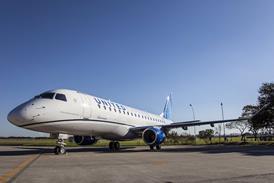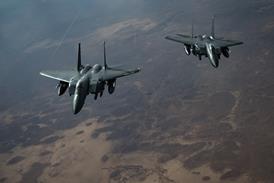When it comes to pilot training, one size definitely does not fit all. That’s according to one of the key proponents of the UK-based Wings Alliance initiative, Cardiff Aviation chairman Bruce Dickinson.
Formally launched late last year, Wings Alliance pools the expertise of a select group of training schools in the UK and mainland Europe, to offer an alternative route into the cockpit to the major cadet schemes established to meet the needs of large mainline operators and low-cost carriers (LCC).
The modular scheme looks to prepare new entrants to the multi-crew co-operation (MCC) standard, while giving them the freedom to select when and where to complete course elements – all at European Aviation Safety Agency-approved facilities. By doing so, they can take advantage of a significantly lower price than when using an integrated training system, and potentially while also holding down a “normal” job to help fund the activity.
“It’s about 30% less [money] than doing the full-time course, and I think it’s a superior product,” says Dickinson, who also serves as Cardiff Aviation’s head of training. Advantages include the provision of upset recovery training for all students in an aerobatic aircraft, with their learning reinforced in a full-motion simulator, he says.
Wings Alliance students can work with partner providers throughout their instruction, including potentially starting at Bristol Groundschool, or come into the scheme following a gap from previous training or a career break. In addition to several training schools in the UK, current members include facilities in France, Greece, the Netherlands and Poland, plus Jordan.
Dickinson says the most important aspects of training are imbuing a culture of safety, and that “you are first and foremost a pilot, who is there to fly the aeroplane and maintain a safe outcome to every flight”.
Referring to the industry’s more traditional cadet training pipeline as a “sausage machine” due to its highly regimented output, he claims: “The perception that that is the only way you can provide the right outcome in terms of a safe, well-trained, flexible pilot attitude is nonsense.
“Airlines want to know not just that somebody can pass the ATPL [airline transport pilot licence] exams and fly a single-crew ILS [instrument landing system approach] in a twin-engined aeroplane – they want to know that people can function in an airline, two-crew environment, and can fly the jet, have situational awareness and – if the automatics fail, that they can correct the upset and land safely.”
Noting that carriers need to be able to see that cadets have completed all required training with top-quality suppliers, he notes: “Airlines want to see a paper trail; they want evidence-based learning. It should not be beyond the wit of man to provide that with a functioning modular-based training system.”
With record order backlogs for commercial airliners – and particularly narrowbodies such as the Airbus A320neo and Boeing 737 Max – there is bumper demand for pilots, but the industry faces a significant recruitment challenge, due to the high cost of entry for would-be applicants: typically in excess of £100,000 ($132,000) on an integrated programme.
By opting to take the modular route offered by the Wings Alliance and other providers, Dickinson claims that new pilots can save money and also join the industry with a more rounded set of skills than those provided along more strictly regimented lines.
“The balance needs to be redressed,” he says. “It’s not all about full-time, living in a Portacabin and wandering around like it’s a campus university. It’s not all about the polished uniform.” For some, the tight routine of multiple early starts and flying repetitive routes with an LCC also does not fit, he contends, noting: “Unfortunately for EasyJet, some of the pilots don’t love it.”
This is where a company like Cardiff Aviation – with its own registered airline operating under the aircraft, crew, maintenance and insurance (ACMI) model – could offer a viable alternative.
“ACMI airlines in particular are very suitable [for gaining experience], because we fly to lots of interesting places,” he says. “We require a great deal of initiative and good handling skills. So a pilot that comes up through the school of ACMI carriers goes away with a very strong skillset that includes management and turning his/her hand to different jobs. I think it’s a great learning environment.”
But where the LCC operators and mainline carriers do hold an unarguable advantage is in scale and increased job security: a challenge which Dickinson says the Wings Alliance partners have been aware of “since day one”.
“People who are committing a huge amount of money will only do so when they say ‘where’s the aeroplane at the end of it’,” he concedes, but adds: “Wings Alliance comes into its own when you tie an airline on to the end of it.”
Speaking to FlightGlobal at the company’s Cardiff airport facility in August, Dickinson revealed that Cardiff Aviation is poised to launch a cadet programme in partnership with Air Atlanta Icelandic; one of its largest current training customers.
Last year the operator sent about 60 students through MCC and jet orientation course (JOC) training at the Welsh site, with this volume required to support its provision of services with Boeing 747-400s in both the passenger and freighter sectors.
Key to the partnership’s success are Cardiff Aviation’s pair of 747-400 full-motion simulators: an ex-South African Airways example and another acquired from Japan Airlines. The latter has recently been upgraded to a Level D device and is now pending certification for use.
The company’s current MCC process concludes with students accumulating 40h in the simulators. This can be built on with a further 40h during a subsequent JOC that it provides: a combined total which Dickinson says is “virtually a type rating”. A further 100h of training completes conversion to type.
Dickinson used Cardiff Aviation’s simulators for his own type conversion on to the 747-400, ahead of flying one of Air Atlanta Icelandic’s passenger examples during his band Iron Maiden’s world tour earlier this year. He flew 52 sectors in the left-hand seat of the specially liveried “Ed Force One”, including an initial 10 flights covering remaining line training and line check activities, and performed 45 landings.
As well as preparing pilots for the partner carrier’s widebody fleet, the new cadet programme will provide new recruits for Cardiff Aviation’s registered airline, VVB Aviation Malta. This has been providing services between Sicily and the Italian mainland with 737s, and Dickinson hopes to have four or more aircraft available to provide additional capacity for other airlines in Europe by mid-2017.
The company also has provided a first 737-400 for the reborn Air Djibouti, and commenced revenue services with the Maltese-registered twinjet (9H-VVB) in mid-August. The carrier is now establishing a network which will initially serve destinations in Ethiopia, Saudi Arabia and Somalia, and plans to later add locations in Burundi, Kenya, Rwanda and Sudan, plus Dubai, to its services. It should soon introduce a pair of BAe 146s on wet-lease, and from late this year or early in 2017 operate an Air Djibouti-owned 767-200ER between the nation and London Gatwick airport.
Dickinson believes the same model – which Cardiff Aviation refers to as an “airline in a box” service, due to it also providing personnel training and maintenance services – could be adopted by other operators in Africa and Southeast Asia.
The offer of such career variety could prove attractive to some of Wings Alliance’s potential recruits. While the scheme is still in its early days, Dickinson believes that the quality of instruction and experience gained by its new pilots will speak for itself once they gain seats with established carriers. And he hopes that mindsets will change with regard to major airlines considering entrants who are seeking to join their ranks via the modular route.
“Everybody wants to hire an enthusiastic, well-trained pilot,” he concludes. “There’s no such thing as a promise of a job, but people need pilots.”
Source: Flight International


























